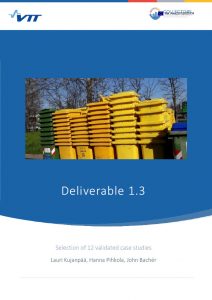Selection of case studies
The selection of case studies was made on the basis of the extensive collection of information performed by the consortium as the first step of the project. methods of group decision-making were applied. Altogether three multicriteria decision-making (MCDM) exercises were conducted as part of the Regional Working Group (RWG) meeting that took place in Malta, in September 2018. During the RWG meetings, MCDM was applied for collecting feedback and opinions from the members of the RWG and other invited local and European experts in a structured way.
The discussions led to the identification of indicators allowing the identification of good practices for the three waste fractions, as well as external conditions that should be taken into account when selecting the case study, to ensure a proper representativeness of the selected case studies. The assumption was to select the five highest-ranking PPW and WEEE cases that include all permutations of two constraining parameters, measured whether the case is higher or lower than median.
Selection of the WEEE cases
Among nine performance criteria selected by the consortium and based on the available data, the indicators that were regarded as the most relevant ones for the selection of case studies was the collected quantities per inhabitant, and the share of WEEE in residual waste.
As for external parameters, both population density and GDP were identified as the more interesting contextual indicators. Indeed, very high density and remote areas both makes it challenging to develop an efficient network of collection points.
Selection of the PPW cases
Eleven performances indicators were discussed; capture rate of plastic seemed to be a relevant indicator to identify interesting case studies, along with the capture rate of paper and cardboard.
The identified external parameters were “tourism and commuters” (as overnight stays per capita) and “total MSW generation per capita“.
Selection of the CDW cases
The information available on CDW collection systems and the important differences of collection systems for this waste fraction made it more challenging to identify proper indicators for the selection of case studies. Indeed, local authorities might handle a very limited share of CDW (e.g. small quantities of inert waste brought by inhabitants), or manage more significant quantities (e.g. various CDW fractions from both household and small companies).
The performance indicators that were selected by the participant were “number of inhabitants per one civic amenity site”, “Share of CDW in mixed residual waste”, and “Existence of feedback gathering mechanisms”.
The selected contextual indicators was the GDP per inhabitants and the type of housing, which can both reflect the significance of construction and demolition in the territory.
Follow up of the MCDM exercises
While the selected parameters provided interesting results, further works were needed to ensure that the collected data allowed a proper identification of the case studies. Possible uncertainties or differences in the scope and definition of indicators could limit the use of quantitative data; qualitative information was also required to consider if the selected case studies were indeed following in the right categories.
Moreover, further criteria were chosen for the selection of indicators: the good geographical coverage of case study, and the sufficient availability of data. Other parameters, such as the willingness of local authority to contribute to data collection, were taken into account.
The selected case studies
The selection of case studies is still on-going, along with the documentation of the quality of sorted material, their economic balance, and their environmental impact. All these elements will be presented soon.
Relevant publications
To discover more on the selection of case studies, have a look at the following publications:
 D1.3 Selection of case studies
D1.3 Selection of case studies
This report describes the approach and methods used for identifying a group of potential cases of collection systems that could be studied during the project, taking into considerations contexts that prove to be challenging and performance indicators that allow the identification of well-performing cases.